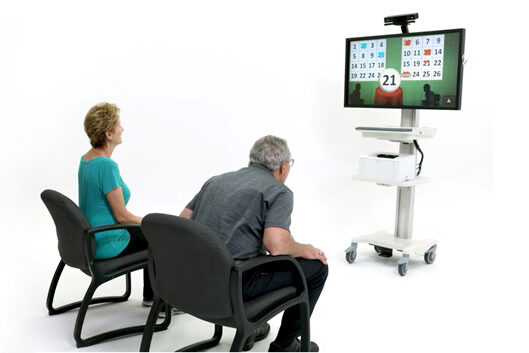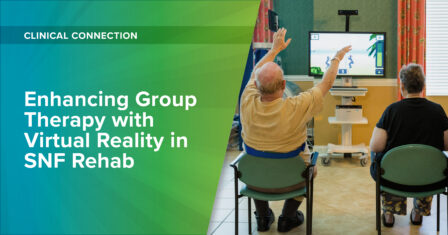The highlights:
- Integrating virtual reality (VR) into group therapy enhances patient engagement and functional outcomes, transforming the rehabilitation experience
- Effective implementation involves selecting collaborative VR activities, fostering healthy competition, and adapting experiences to group dynamics for maximum benefit
- ACP will soon launch a new technology that helps clinicians seamlessly incorporate VR into group therapy
As skilled nursing facilities (SNFs) navigate an increasingly competitive landscape, they constantly seek innovative ways to improve patient outcomes, drive operational efficiencies, and differentiate their rehabilitation programs. We recently covered how VR could transform skilled rehab. By thoughtfully integrating VR into group therapy sessions, clinicians can tap into synergies that address the key goals of modern SNFs: boosting patient engagement, enhancing functional outcomes, and optimizing the efficiency of care delivery.
The Synergies of VR and Group Therapy

We have explored the individual benefits of VR and group therapy in SNF rehab. VR has proven to be an innovative solution that can increase patient engagement, encourage longer and more intense therapy sessions, and positively impact patient mood.1, 2 Meanwhile, group therapy settings have been shown to foster a supportive environment that enhances socialization, promotes healthy competition, and allows for more cost-effective care delivery.
Together, group therapy and VR unlock a world of possibilities. The immersive, interactive nature of VR can take the group therapy experience to new heights, motivating patients to push the boundaries of their abilities while enjoying the camaraderie and encouragement of their peers. The social dynamics of group therapy can further amplify the engagement and therapeutic value of the VR experience.
Practical Strategies for Incorporating VR into Group Therapy
So, how can SNF clinicians harness the power of this dynamic duo? Here are some practical strategies for incorporating VR into group therapy sessions:
Choose VR Experiences that Promote Collaboration
Select VR applications that encourage teamwork and group interaction. For example, choose multiplayer activities where patients work together to achieve a shared goal or VR environments that simulate real-world tasks requiring coordination.
Foster Friendly Competition
Competition knows no age! Incorporate VR activities that allow patients to compete against their peers in a fun, supportive environment. Healthy rivalry can boost engagement and motivation, pushing participants to go beyond their perceived limits.
Leverage Dual-Task Training
Use VR to introduce cognitive challenges alongside physical exercise. As patients navigate the virtual world, have them perform tasks that engage both the body and the mind, such as remembering sequences, solving puzzles, or making decisions. This dual-task training can enhance overall functional abilities.
Adapt VR Experiences to Group Dynamics
When choosing VR applications, be mindful of group size, patient abilities, and therapy goals. Customize the virtual environments and tasks to ensure all participants are appropriately challenged and can actively engage with each other.
Complement VR with Traditional Group Activities
While VR can be an excellent supplement to group therapy, it should never wholly replace more conventional group activities. Combine VR experiences with traditional group activities to create a well-rounded rehab program.
Elevating Rehabilitation Outcomes with VR-Enhanced Group Therapy
By combining evidence-based group therapy and VR, clinicians can foster better engagement, improved functional outcomes, and a heightened sense of community that supports the whole patient.
This powerful combination can change how patients experience rehabilitation, which is why we are excited to share that we will soon launch a new, immersive VR technology that integrates seamlessly into group therapy – keep an eye out for more on that soon. In the meantime, as you continue to explore ways to optimize your skilled nursing rehabilitation program, consider the transformative potential of VR-enhanced group therapy. This dynamic combination can help you deliver exceptional care and position your facility for long-term success.
Stay Connected with ACP
Be the first to hear about ACP product launches, news, and more by following us on social media.
- Kizmaz, E., Telli Atalay, O., Çetin, N., & Uğurlu, E. (2024). Virtual reality for COPD exacerbation: A randomized controlled trial. Respiratory Medicine, 230, 107696. https://doi.org/10.1016/j.rmed.2024.107696 ↩︎
- D’Cunha, N. M., Nguyen, D., Naumovski, N., McKune, A. J., Kellett, J., Georgousopoulou, E. N., Frost, J., & Isbel, S. (2019). A mini-review of virtual reality-based interventions to promote well-being for people living with dementia and mild cognitive impairment. Gerontology, 65(4), 430-440. https://doi.org/10.1159/000500040 ↩︎
As skilled nursing facilities (SNFs) navigate an increasingly competitive landscape, they constantly seek innovative ways to improve patient outcomes, drive operational efficiencies, and differentiate their rehabilitation programs. We recently covered how VR could transform skilled rehab. Learn how you can combine VR with group therapy to boost patient engagement, enhance functional outcomes, and optimize care delivery.


